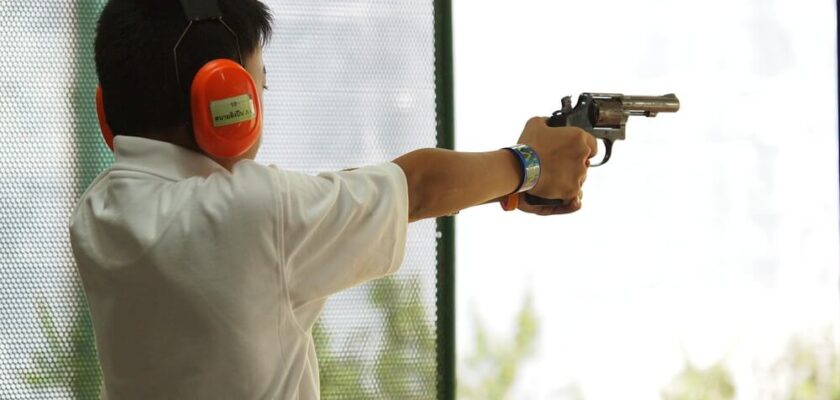The rules of shooting are essential so that all athletes have a similar chance of victory and are aligned on what can and cannot be done within the sport and each competition.
However, more than that, when it comes to shooting sports, safety is an essential element, so strict rules are in place to guarantee the physical integrity of all competitors and those around them.
With this in mind, the rules of sport shooting become clearer if we divide this manual into a few categories of rules. And that’s exactly what we’ve done below, with rules for competition, safety, equipment and more. Read on and get all your questions answered about the rules of shooting sports.
Open your Betano account and get up to 1,000 reais in bonuses.
PIX payments, live games and super odds!
Click here to open your account!
Uncomplicated (and complete) shooting rules manual
In the shooting rules categories, you’ll find:
- Shooting rules on scoring
- Rules on categories and types of weapon
- Classification rules
- Safety rules
- Equipment
Shooting rules on scoring
Scoring is generally based on the accuracy of the shots in relation to the center of the target. In other words, the closer to the center of the target the athlete hits the shot, the higher their score.
In skeet shooting, however, scoring is a little different. In this format, points are awarded according to the number of plates broken by the shots fired by each athlete.
Rules on categories and types of weapon
Shooting competitions are divided by gender (male and female) and age group (junior and senior).
There are also categories for shooters with disabilities, and there is even a Paralympic shooting discipline at the Paralympics. In this format, there are three categories according to shooting positions: standing, lying down and kneeling.
It’s worth mentioning that athletes, whether Olympic or Paralympic, are also divided into categories according to the type of weapon and distance from the target.
Here are the rules of shooting sports in relation to the weapons used.
10m Air Pistol
- Distance: 10 meters.
- Target: ISSF standard target with 10 scoring rings.
- Number of shots: 60 shots (men) and 40 shots (women).
- Time: 75 minutes (men) and 50 minutes (women).
- Caliber: 4.5 mm air pistol (.177 cal).
10m Air Carbine
- Distance: 10 meters.
- Target: ISSF standard target with 10 scoring rings.
- Number of shots: 60 shots (men) and 40 shots (women).
- Time: 105 minutes (men) and 75 minutes (women).
- Caliber: 4.5 mm air rifle (.177 cal).
50m Free Pistol
- Distance: 50 meters.
- Target: ISSF standard target with 10 scoring rings.
- Number of shots: 60 shots.
- Time: 120 minutes.
- Caliber: 5.6 mm round firearm (.22 cal).
50m Small Caliber Carbine (Lying Down)
- Distance: 50 meters.
- Target: ISSF standard target with 10 scoring rings.
- Number of shots: 60 shots.
- Time: 50 minutes.
- Caliber: Small caliber carbine 5.6 mm (.22 cal).
50m Small Caliber Carbine (3 Positions)
- Range: 50 meters.
- Target: ISSF standard target with 10 scoring rings.
- Number of shots: 120 shots (men) and 60 shots (women) divided equally between the kneeling, lying and standing positions.
- Time: 3h 30min (men) and 2h 15min (women).
- Caliber: 5.6 mm small caliber carbine (.22 cal).
Skeet
- Format: Shooting clay discs thrown from two different squares.
- Number of shots: 125 discs (5 series of 25) in the qualifying round, plus 60 discs in the semi-finals and finals.
- Specific rules: Each shooter must fire at a disc thrown from each house at different angles and speeds.
Trap
- Format: Shooting clay discs from a single square in different directions.
- Number of shots: 125 discs (5 series of 25) in the qualifying round, plus 60 discs in the semi-finals and finals.
- Specific rules: The discs are thrown at different heights and angles.
Classification rules
The final classification of athletes is based on the total score of each shooter throughout the competition. It’s important to note that each tournament has its own rules regarding classifications, such as the number of athletes who qualify. It is therefore essential to be aware of the regulations.
However, in the finals, shooters generally start from scratch and the accumulated score decides the winners.
In the event of a tie, additional rounds are fired until the winner is decided.
Safety rules
The safe handling of firearms is paramount, so at all times during the tournament, weapons must be treated as if they were loaded.
Safety equipment is also mandatory, including the use of goggles and ear defenders.
The shooter should always point the gun in a safe direction and never put their finger on the trigger until they are ready to fire.
Equipment
Weapons and ammunition must conform to the specifications of the ISSF, the International Shooting Sports Federation, according to each discipline.
Auxiliary equipment, such as shooting clothes, gloves and supports, also have specific regulations and need to be consulted at each tournament.
In addition to these shooting rules, it’s essential to keep an eye on the regulations for each competition to ensure that all the rules are complied with and that you don’t run into problems with fouls or disqualification due to carelessness.
Shooting is a complex and rigorous sport, and is even part of the modern pentathlon, one of the most difficult and complex disciplines in sport.
Knowing and following these rules is essential for any shooter who wants to compete at the highest level. Whether you’re a beginner, a veteran or just curious, understanding these guidelines is fundamental to success and satisfaction in the sport of shooting.
Open your Betano account and get up to 1,000 reais in bonuses.
PIX payments, live games and super odds!



